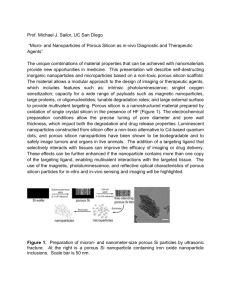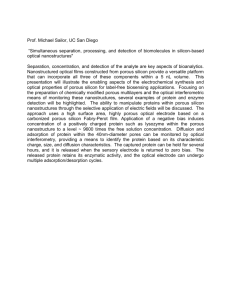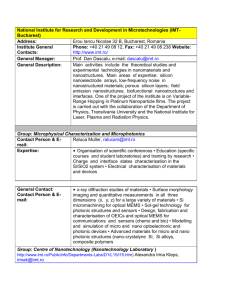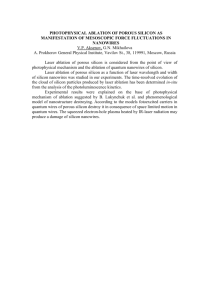Research Journal of Applied Sciences, Engineering and Technology 2(3): 208-215,... ISSN: 2040-7467 © M axwell Scientific Organization, 2010
advertisement
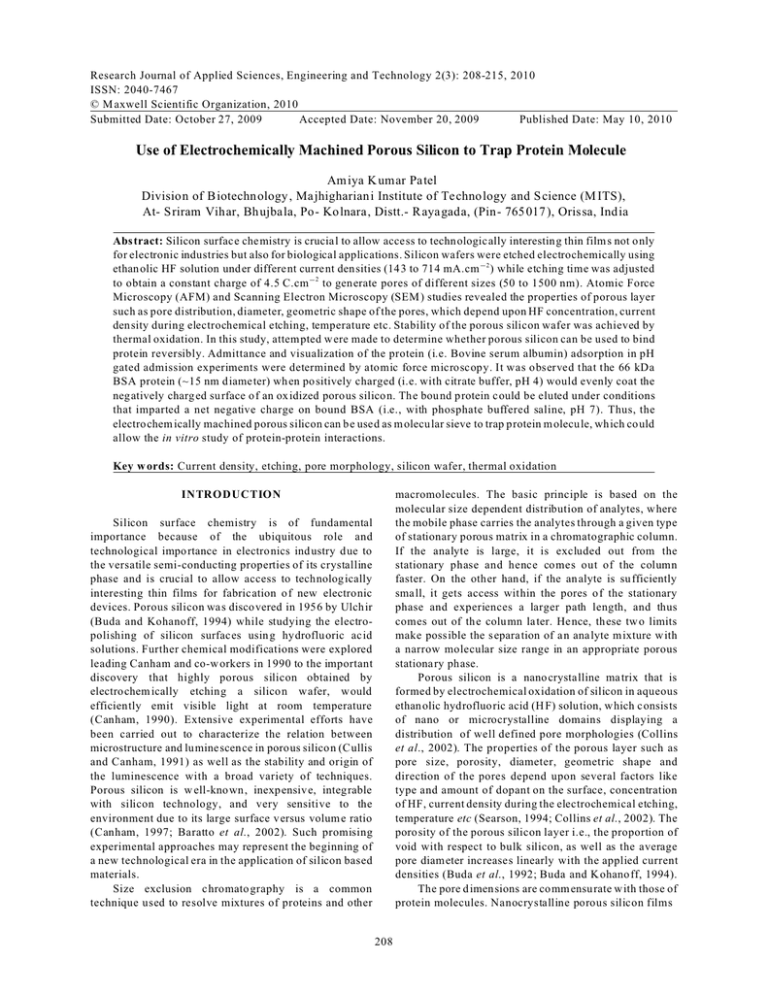
Research Journal of Applied Sciences, Engineering and Technology 2(3): 208-215, 2010 ISSN: 2040-7467 © M axwell Scientific Organization, 2010 Submitted Date: October 27, 2009 Accepted Date: November 20, 2009 Published Date: May 10, 2010 Use of Electrochemically Machined Porous Silicon to Trap Protein Molecule Am iya K umar Patel Division of Biotechnology , Majhigharian i Institute of Technology and Science (M ITS), At- Sriram Vihar, Bh ujbala, Po- Kolnara, Distt.- R ayagada, (Pin- 765 017 ), Orissa, India Abstract: Silicon surface chemistry is crucial to allow access to technologically interesting thin film s not only for electronic industries but also for biological applications. Silicon wafers were etched electrochemically using ethan olic HF solution under different current den sities (143 to 714 mA.cmG 2 ) while etching time was adjusted to obtain a constant charge of 4.5 C.cmG 2 to generate pores of different sizes (50 to 1500 nm). Atomic Force Microscopy (AFM) and Scanning Electron Microscopy (SEM ) studies revealed the properties of porous layer such as pore distribution, diameter, geometric shape of the pores, which depend upon HF concentration, current density during electrochemical etching, temperature etc. Stability of the porous silicon wafer was achieved by thermal oxidation. In this study, attem pted were made to determine whether porous silicon can be used to bind protein reversibly. Admittance and visualization of the protein (i.e. Bovine serum albumin) adsorption in pH gated admission experiments were determined by atomic force microscopy. It was observed that the 66 kDa BSA protein (~15 nm d iameter) wh en po sitively charged (i.e. with citrate buffer, pH 4) would evenly coat the negatively charg ed surface of an ox idized porous silicon. The bou nd protein could be eluted under conditions that imparted a net negative charge on bound BSA (i.e., with phosphate buffered saline, pH 7). Thus, the electrochem ically machined porous silicon can be used as m olecu lar sieve to trap protein m olecu le, wh ich could allow the in vitro study of protein-protein interactions. Key w ords: Current density, etching, pore morphology, silicon wafer, thermal oxidation macromolecules. The basic principle is based on the molecular size dependent distribution of analytes, where the mobile phase carries the analytes through a given type of stationary porous matrix in a chromatographic column. If the analyte is large, it is excluded out from the stationary phase and hence comes out of the column faster. On the other han d, if the an alyte is su fficiently small, it gets access within the pores o f the stationary phase and experiences a larger path length, and thus comes out of the column later. Hence, these tw o limits make possible the separa tion of an ana lyte mixture w ith a narrow molecular size range in an appropriate porous stationa ry phase. Porous silicon is a nano crystalline ma trix that is formed by electrochemical oxidation of silicon in aqueous ethan olic hydrofluoric acid (H F) solu tion, w hich consists of nano or microcrystalline domains displaying a distribution of well defined pore morphologies (Collins et al., 2002). The properties of the porous layer such as pore size, porosity, diameter, geometric shape and direction of the pores depend upon several factors like type and amount of dopant on the surface, concentration of HF, current density during the electrochemical etching, temperature etc (Searson, 1994; Collins et al., 2002). The porosity of the porous silicon layer i.e., the proportion of void with respect to bulk silicon, as well as the average pore diameter increases linearly with the applied current densities (Buda et al., 1992; Buda and K ohano ff, 1994). The pore d imensions are comm ensu rate w ith those of protein molecules. Nanocrystalline porous silicon films INTRODUCTION Silicon surface chemistry is of fundamental importance because of the ubiquitous role and technological impo rtance in electro nics ind ustry due to the versatile semi-conducting properties of its crystalline phase and is crucial to allow access to technolog ically interesting thin films for fabrication of new electronic devices. Porous silicon was disco vered in 1956 by Ulch ir (Buda and Kohanoff, 1994) while studying the electropolishing of silicon surfaces usin g hydrofluoric acid solutions. Further chemical modifications were explored leading Canham and co-w orkers in 1990 to the important discovery that highly porous silicon obtained by electrochem ically etching a silicon wafer, w ould efficiently emit visible light at room temperature (Canham, 1990). Extensive experimental efforts have been carried out to characterize the relation between microstructure and lumine scence in porous silicon (Cullis and Canham, 1991) as well as the stability and origin of the luminescence with a broad variety of techniques. Porous silicon is w ell-kno wn, inexpensive, integrable with silicon technology, and very sensitive to the environment due to its large surface versus volum e ratio (Canham, 1997; Baratto et al., 2002). Such promising experimental approaches may represent the beginning of a new technological era in the application of silicon based materials. Size exclusion chromato graphy is a common technique used to resolve mixtures of proteins and other 208 Res. J. Appl. Sci. Eng. Technol., 2(3): 208-215, 2010 Fig. 1: Circuit employed to provide constant current for electrochemical etching of silicon wafer can be used as chromatography matrices (Higanaka et al., 1990; Letant and Sailor, 2001; Strange et al., 2003; Chen et al., 2004; Lin et al., 2007; Anglin et al., 2008). Together they present the possibility of coupling the detection and separation processes as simultaneous events (Lin et al., 2007). Porous silicon has been employed as a large surface area matrix for the immobilization of a variety of molecules (Lin et al., 2007; Schwartz et al., 2007; Jang et al., 2008; Park et al., 2009) including enzymes (Drott et al., 1998, 1999; Bengtsson et al., 2002; Letant et al., 2004 ; Orosco et al., 2009) and antibodies (Laurell et al., 1999). Internal-surface Reversed-phase Silica (ISRP) support was used to determin ation of hydrophilic or hydrophobic drugs in serum or plasma (Higanaka et al., 1990; Letant and Sailor, 1999; Jang et al., 2008) and drug delivery (Chen et al., 2004 ; Anglin et al., 2008). Microfabricated devices operated in a flowthrough mode over flat surface design containing arrays of nucleic acid hybridization sites, known as genosensors, are being developed for a variety of uses in genomic analy sis (Beattie et al., 1995). In addition, porous silicon has been identified as a potential optoelectronic material (Gao et al., 2000; Youssef, 2001; Baratto et al., 2002; Alwan, 2007) an d used as pressure sen sor (Sujath a and Bhattacharya, 2009). It is thus o f primary interest to determine the possible configuration in wh ich porous silicon flims can be used to trap protein molecules according to their three dimensional structure and size, which wou ld have immense practical utility in the study of biology. Physics when I was perusing my visiting student research programme during 2002 at Tata Institute of Fundamental Research, Mum bai. Further, I have taken the help of Central Sophisticated Analytical Instrum entation Facility at TIFR for taking Atomic force microscopic and Scanning electron microscop ic imag es to characterize the freshly etched silicon wafer for the pH gated admission experiment. Circuit used for Etching: The basic need of the circuit (Fig. 1) was to provide a continuo us constant current supp ly for etching the silicon wafer at different current densities. In this circuit, the input power supply is 15 V and source voltage was positive referred to as collector bias. The instrument used for etching of silicon wafer was connected in series with the circuit. The diode (BY-126) used in this circuit can be thought of as a switch, which is controlled by the polarity of the source voltage. The diode conducts the current only from (p) to (n) and conduction takes place only w hen the source voltage is positive. In addition, a transistor made of up semi-conducting materials (SL-100B) was used for current amplification, which was initiated in base current rather than emitter curren t. A 9V battery is connected to the base of the transistor was referred to as base bias. B esides these; a variab le resistor current control (100W, 5W ) was used in the circuit by which the current supply required for etching was manipulated as per the requirement and a current limiting resistor (15 O hm, 1 0 w) was used to maintain the overall current supply connected to the ground. MATERIALS AND METHODS Electrochemical preparation of porous layer: Heavily doped p-type silicon wafers of orientation (100) with resistivities within a range of 0.6-1.0 m O hm cm were The study was conducted in the Department of Biological Sciences and Department of Condensed matter 209 Res. J. Appl. Sci. Eng. Technol., 2(3): 208-215, 2010 used to fabricate porous silicon. Prior to etching, silicon wafers were rinsed and w ashed with trichloro ethylene to remove surface imp urities. In addition, the wafers w ere subjected to ultrasonic cleaning for 2 min followed by boiling for 2 min in trichloroethylene. The silicon wafers were then dried under a stream of nitrogen and dippe d in concentrated HF solution to remove any remaining impurities. The silicon films were washed thoroughly with abso lute ethyl alcoho l and dried under a stream of nitrogen. A silicon wafer of an expo sed area of about 0.7 cm 2 was mounted in a teflon etching shell (Fig. 2). A platinum mesh served as the counter electrode used to provide a homogenous electric field. Etching was performed in ethanolic H F solu tion (HF : EtOH = 3:1, v/v) prepa red w ith 48% HF in water. Galv anometric anodization was performed with current densities ranging from 143 to 714 mA.cmG 2 while etching time was adjusted to obtain a constant charge of about 4.5 C.cmG 2 . After etching, the film s we re rinsed thoroughly with absolute ethanol and dried under a stream of nitrogen. Fig. 2: Diagrammatic representation of the etching cell used for electrochemical etching of silicon wafer. Characterization of porous silicon films: To characterize the porous silicon films, atomic force microscopy (AFM) images were obtained using a Nanoscope–IIIa multimode scanning probe microscope operating in tapping mode, measuring the surface topography of the porous silicon by recording the feedback output and the cantilever deflection, which can achieve resolution upto 10 pico meter. In addition, Scanning Electron M icroscopy (SEM ) image of cross section of the freshly etched silicon film was also obtained with Cambridge 360 electron microscope using an accelerating voltage of 20 KeV to determine the pore dimension within the porous layer. Tab le 1: Electrochemical etching o f silicon wafer at different current densities (143 to 714 mA.cm G 2 ) generating pores of 50 n m to 200 0 nm pore d iameter. Current Density (mA.cm G 2 ) Pore Diameter(nm) 143 5 – 50 285 50 -100 357 100 – 150 428 200 – 400 500 500 – 800 571 800 – 1000 642 1000 – 1500 714 Electropolishing was removed by a further washing with citrate buffer (pH 4.0). Impregnation of the BSA m olecules into the porous silicon film was examined by atomic force microscopy and fluorescence spectroscopy. The porous silicon used in this experiment had pores size of 1000 nm that was large enough to accommodate the BSA protein (15 nm). Phospha te buffered saline (pH 7.2) was then introduced on the surface of the porous silicon to elute out the BSA trapped on the oxidized silicon surface. Further, the protein bound to the surface of the silicon wafer was estimated using front-face fluorescence spectroscopy. Oxidation of porous silicon: The freshly etched porous silicon was thoroughly rinsed with absolute ethanol and dried under a stream of nitrogen. Thermally oxidized porous silicon samples were obtained by heat trea tment in a furnace tube using the following parameters: initial ramp temperature 5o C.m inG 1 to 400ºC, holding time - 1 h and passiv e coo ling to room tempe rature. RESULTS AND DISCUSSION Pore Morphology: When current flows in the electrochem ical cell, the dissociation reaction localizes on a particular side of a silicon surface, thus initiating the etching of an array of pores in the silicon wafer. The po re morphology was analyzed under conditions of varying current densities. At low current density, a high ly branched, randomly directed and highly inter-connected meshwork of pores w as obtained. How ever, increasing in current density orders the sm all pores to exhibit cylindrical shapes giving rise to larger pore diameter pH Gated adm ission expe rimen t: The oxidized porous silicon films were initially washed with a 10% (v/v) solution of ethanol in deionized water followed by the buffer solution (i.e. citrate buffer, pH 4.0). Then, 100 :l of the BSA (i.e., Bovine Serum A lbum in) protein sam ple consisting of 1 mg.mlG 1 protein (15mM) in citrate buffer (pH 4.0) was gently introduced over the surface of the porous silicon wafer. Non-specifically adhered protein 210 Res. J. Appl. Sci. Eng. Technol., 2(3): 208-215, 2010 (A) (B) (C) (D) (E) (F) 211 Res. J. Appl. Sci. Eng. Technol., 2(3): 208-215, 2010 (G) (H) Fig. 3: AFM images of porous silicon layers etched at different current densities: (A) 143 mA.cmG 2 (B) 285 mA.cmG 2 (C) 357 mA.cmG 2 (D) 428 mA.cmG 2 (E) 500 mA.cmG 2 (F) 571 mA.cmG 2 (G) 642 mA.cmG 2 (H) mA.cmG 2. All samples were etched to a constant charge of 4.5 C.cmG 2. The study suggested that the pore morphology and dimension depends upon the etching condition, applied voltage and HF concentration (Canham, 1990, 1997; Collins et al., 2002). The pore morphology is also determined by a combination of electric current and a chara cteristic non-linearity parameter, which depends on specific properties of the substrate like dopant level and temperature (Canham, 1997; Searson, 1994; Collins et al., 2002). The doping of the silicon wafe r mod ifies its resistivity and conse quently the local electrical field inside the anode (Canham, 1990; Buda et al., 1992; Youssef, 2001 ). Fig. 4: Cross-sectional SEM image (1 x 1 : m2 ) of porous silicon etched at 571 mA.cmG 2 for 8 sec. Oxidation of porous silicon: The surface of the freshly etched porous silicon film was predominantly hydrideterminated and unstable in aqueous solution, readily suffers oxida tive and hydrolytic corrosion. T herefo re, to obtain a stable porous layer surface in an aque ous buffer, the porous layer was subjected to oxidation prior to use. Thermal oxidation converts the hydride terminated porous silicon surface into a stabilized form by the incorporation of oxygen into the silicon crystal lattice and gives termination with silyloxy (Si-O -Si), hydroxy (Si-OH ), alkoxy (Si-OR ) groups or a combination of these three functionalities (Robins et al., 1999; Letant and Sailor, 1999). Again, hydroxy (Si-O H) term inated surfaces can then undergo condensation reaction with alkoxy- or chlorosilanes to produce a new (Si-O-Si) linkage covering the porous surface with a layer o f oxide (SiO 2 ) that was negatively charged even at moderately low pH values (Canham, 1990, 1997; Searson, 1994; Collins et al., 2002). (Buda and Kohanoff, 1994; Beattie et al., 1995; Canham, 1997; Collins et al., 2002). The study revealed that the current densities used in this experiment ranged from 143 to 714 mA.cmG 2 supplemented a good gradation of pore diameters varied from 50 to 1500 nm (Table 1). Eventually, the detachment of the porous layer occurs at current density higher than 700 mA.cmG 2 referred to as ‘electro-polishing’ (Collins et al., 2002) (Fig. 3, A-H ). Besides these, the cross sectional image of a freshly etched porous silicon showing the characteristics cylindrical pore m orphology describes the pores as a bundle of cylinders (Fig. 4). It is difficult to o btain reliable information about the pore size from the samples with pores smaller than 5 nm because in this size regime the apparent pore size strongly depends on shape of the SEM probe and the threshold height chosen. Imaging the larger macro-pores (> 800 nm ) can result in un stable scans because the tip loses contact with the surface over a relatively long distance. In particular, the large macropores have blackish appearance due to the predominant interaction of the side o f tip and with the pore wall. pH Gated adm ission expe rimen t: In order to adsorb the BSA (i.e., Bovine serum albumin) protein on the negatively charged surfaces of oxidized porous silicon 212 Res. J. Appl. Sci. Eng. Technol., 2(3): 208-215, 2010 (A) (B) (C) (D) (E) (F) Fig. 5: AFM images demonstrating the pH gated adsorption of BSA on Porous Silicon by monitoring surface topography. (A) silicon wafer without etching; (B) oxidized porous silicon; (C) oxidized porous silicon washed with 10% EtOH; (D) oxidized porous silicon washed with citrate buffer of pH 4; (E) oxidized porous silicon showing trapped BSA protein in pH 4 buffer solution (F) after washing with pH 4 buffer. The silicon wafer was etched at 642 mA.cmG 2 for 7 sec 213 Res. J. Appl. Sci. Eng. Technol., 2(3): 208-215, 2010 surface like a blanket (Fig. 5E). Washing away the nonspecifically adsorbed protein using citrate buffer (pH 4.0) results in a somewhat sharper landscape (Fig. 5F ) still showing considerable protein covering the porous silicon. Spectacularly, the subsequent washing of silicon wafer with phospha te buffered saline (pH 7.2) comple tely removes the adsorbed BSA protein (Fig. 5G) resulting in a surface topography similar to that observed in Fig. 5D prior to the admission of the protein. The study revealed that the electrochemically machined porous silicon can be used as the stationa ry phase as in chromatogra phic separation (Higanaka et al., 1990; Lin et al., 2007 ; Gritti and G uiochon , 2009). CONCLUSION Fig. 5: (continued). AFM images of (G) after elution of BSA with phosphate buffered saline, pH 7.2 The abov e exp eriments convinc ingly d emo nstrate that protein can be adsorbed onto the surface of porous silicon in a controlled manner, where the adsorption and elution from the negatively charged pore surface can be determined by the net charge on the biomolecule. This property in itself can be used to study biological interactions of macromolecules with one another. The extrem ely high surface area within a small volume provided by porous silicon results in very high effective concentrations of protein adsorbed on these surfaces. This could allow the in vitro study of protein-protein interactions of phy siologically effective protein concentrations, where proteins are often sequestered within two-dimensional membrane micro-domains thereb y grea tly increasing their effective concentrations. Furthermore, the net negative charge on the surface of oxidized porous silicon can conceivably be neutralized by treatment with positively charged small ligands like polylysine, which could then prevent charge-based surface adsorption of proteins on the porous silicon and may be used as a macromolecular sieve. This study further supplemented that a gra dient of electrochem ically machined porous silicon can be used not only to trap protein molecules, but also separation of proteins as simultaneous events. films, the protein must bear a net positive charge. The isoelec tric point of BSA is approxim ately 5. BSA w ill thus display net positive charge at solution pH value below 5 i.e. with citrate buffer (pH 4.0). By the same token, it will bear a net negative charge w ith pho spha te buffered saline (pH 7.2) due to the pK a values of the constituent amino acid residues. These considerations were used to selectively adsorb positively charged BSA on the negatively charged oxidized porous silicon surface at pH 4 and to elute it off under conditions of pH 7.2. Thus, the electrostatic interaction betw een the SiO 2 covered pore surface and the protein can be varied allowing the adsorption and release of the protein to be experimentally controlled (Canham, 1990; Collins et al., 2002). As because BSA contains three tryptophan residues that could serve as intrinsic fluorophores, the protein bound to the surface of the silicon wafer was estimated using front-face fluorescenc e spectroscopy to determine the emission of tryptophan fluorescence (Excitation: 280 nm, Emission: 340 nm) proved successful. Further, attemp ts were made to read-out of adsorbed BSA protein in terms of three-dimensional representation of a (1 x 1) :m 2 area of porous silicon wafer subjected to various treatme nts usin g atom ic force microscop ic studies. The AFM study suggested that the silicon wafer prior to etching showed relatively flat and featureless surface (Fig. 5A) while blurring of the surface w ith hills and valleys corresponding to the pore distribution obtained by etching th e silicon at a current density of 642 mA.cmG 2 (Fig. 5B). This surface was washed with 10% ethanol and visualized using AFM (Fig. 5C), which shows no difference. Th e image ob tained after washing silicon wafer with citrate buffer (pH 4.0) looks quite different (Fig. 5D), because citrate buffer is not volatile like ethanol and thus sits trapped on the ridged surface of the silicon wafer. W hen BSA w as introd uced , the protein seems to cover the entire landscape of the porous silicon AKNOWLEDGEMENT Author is thank ful to D r. Roh it Mittal, Department of Biological Sciences and Prof. K.L. Narashimhan, Department of Co ndensed Matter Physics, Tata Institute Fundamental Research (TIFR), Mumbai for providing the laboratory facilities and critical suggestions. REFERENCES Alwan, M.A., 2007. Calculation of energy band gap of porous silicon based on the carrier transport mechanisms. Eng. Tech., 25(10): 1143-1148. Anglin, E.J., L. Cheng, W.R. Freeman and M.J. Sailor, 2008. Porous silicon in drug delivery devices and materials. Adv. Drug Deliv. Rev., 60(11): 1266. 214 Res. J. Appl. Sci. Eng. Technol., 2(3): 208-215, 2010 Baratto, C., G. Faglia, G. Sberveglieri, Z. Gaburro, L. Pancheri, C . Oton and L . Pavesi, 2002. Multiparametric porous silicon sensors. Sensors, (2): 12-126. Beattie, K.L., W.G . Beattie, L. Meng, S.L. Tu rner, R. Coral-Vazqu ez, D . Smith, P.M . McIntyre and D.D. Dao, 1995. Advances in genosensor research. Clin. Chem., 41(5): 700-706. Bengtsson M., S. Ekström, G. Marko-Varga and T. Laurell, 2002. Improved performance in silicon enzyme microreactors obtained by homogeneous porous silicon carrier matrixes, Talanta, 56: 341-353. Buda, F., J. Kohanodd and M. Parrinello, 1992. Optical properties of porous silicon: A first-pinciple study. Phys. Rev. Lett., 69(8):1272-1275. Buda, F. and J. Kohanoff, 1994. Porous silicon: A silicon structure with n ew optical prope rties. Prog. Quant. Elect., 18: 201-226. Canham, L.T., 1990. Observation of optical cavity modes in phospholuminescent porous silicon films. A ppl. Phys. Lett., 57: 507-513. Canham, L.T., 1997. Properties of Porous Silicon. INSPEC, London, pp: 44-86. Chen, J.F., H.M. Ding, J.X. Wang and L. Shao, 2004. Preparation and characterization of porous hollow silica nanoparticles for drug delivery application. Biom aterials, 25(4): 72 3-727. Collins, B.E., K.S. Dancil, G. Abbi and M.J. Sailor, 2002. Determining protein size using an electroch emically machined pore gradient in silicon. Adv. Funct. Mater., 12: 187-191. Cullis, A.G. and L.T. Canham, 1997. A porous silicon based inferometric biosensors. Science, 278: 840-842. Drott, J., L. Rosen gren, K. Lindström and T . Laurell, 1998. Pore morphology influence on catalytic turnover for enzyme activated porous silicon matrices. Thin Solid Films, 330: 161-166. Drott, J., L. Rosen gren, K. Lindström an d T. L aurell, 1999. Porous silicon c arrier matrices in micro enzyme reactors - influence of matrix depth, Mikrochimica Acta, 131: 115-120S. Gao, J., T. Gao an d M .J. Sailor, 2000. Porous-silicon vapour sensor based on laser interferom etry. Appl. Phys. Lett., 77: 901-903. Gritti, F. and G. G uioch on, 20 09. M ass transfer kinetic mechanism in monolithic columns and application to the characterization of ne w research mo nolithic samples with different average pore sizes. J. Chromatogr., 1216(23): 4752-4767. Higanaka, J., J. Wakai, N. Yasuda, H. Yasuda and Y. Kim ura, 1990. Ch aracterization of an internalsurface reversed-phase silica support for liquid chromatography and its application to assays of drugs in serum. J. Chromatograph., 515: 59-66. Jang, S., J. Kim, Y. Koh, J. Park, H. G. Woo, S. Kim and H. Shon, 2008. Fabrication and characterization of surface-derivatized porous silicon "smart particles" for detection of s treptavidin. J. Nanosci. Nanotechnol., 8(10): 5166-5171. Laurell, T., J. Drott, L. Rosen gren and K . Lindstrom, 1999. A porous silicon optical biosensor: detection of reversible bindin g of IgG to a protein-A modified surface. J. Am. C hem . Soc., 121: 7925-7930. Letant, S.E. and M.J. Sailor, 1999. Dervitaized mesoporous silicon with dramatically improved stability in stimulated human blood plasma. Adv. Mater., 11: 1505-1508. Letant, S.E. a nd M .J. Sailor, 2001. Molecular identification by time resolved interferometry in a porous silicon film. Adv. Mater., 13(5): 355-338. Letant, S.E., B.R. Hart, S.R. Kane, M . Had i, S.J. Shields and J.G. Reynolds, 2004. Enzyme immobilization on porous silicon surfaces. Adv . Mater., 16(8): 689-693. Lin, J., X. Wu, X. Lin and Z. Xie, 2007. Preparation of polym ethacrylate monolithic stationary phases having bonded octadecyl ligan ds and sulfonate groups: electrochromatographic characterization and application to the separation of polar solutes for pressurized capillary electrochromatography. J. Chromatogr., 1169(1-2): 220-227. Orosco M.M., C. Pacholski and M .J. Sailor, 2009. Re altime monitoring of enzyme activity in a mesoporous silicon doub le layer. Nature Nan otechno l., 4(4): 255-258. Park, J.H., L. Gu, G. von M altzahn, E. R uoslahti, S.N. Bhatia and M.J. Sailor, 2009. Biod egrad able luminescent porous silicon nanoparticles for in vivo applications. Nature Mater., 8(4): 331-336. Robins, E.G., M .P. Stewart and J.M . Buriak, 1999. Anodic and cathodic electrografting of alkynes on porous silicon. Chem. Commun., October, pp: 2479-2480. Schwartz, M.P., S.D. Alvarez and M.J. Sailor, 2007. Porous SiO 2 interferometric biosensor for quantitative determination of protein interactions: binding of protein A to immunoglobulins derived from different species. Anal. Chem., 79(1): 327-334. Searson, P.C., 1994. Advances in Electrochemical Sciences and Engineering. VCH: Mannheim, Germany, pp: 69. Strange, J.H., J. M itchell and J.B. W ebber, 200 3. Pore surface e xplora tion by N M R . M agn. Reson. Imaging. 21(3-4): 221-226. Sujatha, L. and E. Bhattacharya, 2009. Composite Si/PS membrane pressure sensors with micro and macroporous silicon. Sad hana, 34(4): 643-6 50. You ssef, G.M ., 2001. Effect of etching sequence and aging on photoluminescence of porous silicon. Egypt. J. Soil, 24 (2): 227 -234. 215
